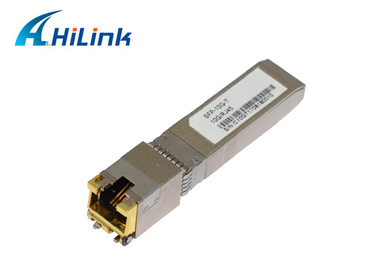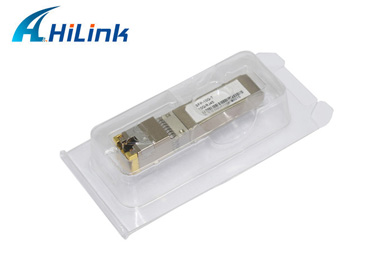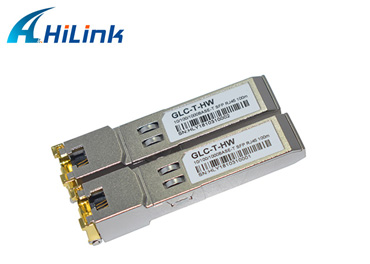How Do I Use the RJ45 SFP Module?
Oct. 08, 2022
Transceiver modules, known as optical devices essential for data transmission, are widely used to connect network applications such as switches and network interface cards. Various types of transceiver modules exist, such as copper SFP, fiber SFP, CWDM SFP, etc. The RJ45 SFP module is a transceiver module that has been used as a legacy solution for many years. This article will provide a clear explanation of the RJ45 SFP module, its benefits, and how to use it.
What is an RJ45 SFP module?
The RJ45 SFP module, also known as a copper SFP, is a hot-swappable transceiver module. It supports 10/100/1000 Mbps data rates over Cat5e or Cat6 cables with RJ45 connector interfaces. It allows communication over twisted copper cables with link lengths of up to 100 m. It is therefore commonly used for transmitting data over short distances, for example for server switching, LANs in data centers, uplinks, or directly to the desktop for broadband applications. Furthermore, as the demand for high-speed communication links continues to grow, some suppliers are starting to implement popular and newer copper modules: the 10GBASE-T SFP+ copper transceiver. It is the first 10G copper SFP RJ45 module required to connect 10 Gb Ethernet over Cat 6a/7 cables and offers great savings and flexibility during network deployments.
Hilink 10G Copper RJ45 SFP+
What is another industry wide application for 10G SFP+ to RJ-45?
Another industry wide application for SFP+ to RJ-45 copper transceivers is Wi-Fi solutions. Wi-Fi access points benefit directly from SFP+ to RJ-45 copper transceiver modules (10G-SFP-T) when the Wi-Fi access point to Wi-Fi controller has an optical infrastructure between the two. In more detail, modern Wi-Fi access points do not usually support fiber optic connections directly but have twisted pair RJ45 ports. Therefore, when a Wi-Fi access point has to be connected to a Wi-Fi controller via a fiber-optic infrastructure, a switch with SFP+ optical ports is required.
On the one hand, the switch is connected directly to the Wi-Fi access point via a twisted-pair cable with the aid of a 10GBASE-T copper adapter. On the other hand, the switch is connected to the Wi-Fi controller via fibre optics with a fibre optic SFP+ module. Important: Older copper infrastructures such as Cat 5e, for example, do not support 10 Gbps data rates. However - the 10GBASE-T copper transceiver data rate can be adjusted from 10GBASE-T to 5GBASE-T or 2.5GBASE-T, or even 1000BASE-T.
Hilink 10/100/1000BASE-T Copper SFP Transceiver
How do I use the RJ45 SFP module?
RJ45 SFP modules are typically used to connect two switches with copper interfaces via Cat5e or Cat6 cables. The following section details how to install, connect and remove RJ45 SFP modules.
Installing the RJ45 SFP module
Attach the anti-static wrist strap to your wrist and to a bare metal surface.
Remove the copper SFP module from its protective packaging.
Locate the copper SFP markings on the module and align them with the front of the slot opening.
Insert the copper SFP module into the slot on the switch until the copper SFP module snaps into place.
Hilink 10/100/1000BASE-T Copper SFP Transceiver
Connecting the Cat5 cable
Insert the Cat5 cable into the RJ45 connector of the copper SFP module.
Ensure that the Cat5 cable is pushed into the copper SFP module.
Removing the RJ45 SFP module
Attach the anti-static wrist strap to your wrist and to a bare metal surface.
Disconnect the cable from the SFP module.
Unlock and remove the copper SFP module
Place the removed SFP module in the protective packaging or anti-static bag.
Hilink (HAILI LINK) Technology Co., Ltd. is specialized in fiber optical products and networking solutions. Our main products are transceiver modules such as QSFP, QSFP28, and CWDM/ DWDM SFP/XFP. For more information and consultation, contact us here!














